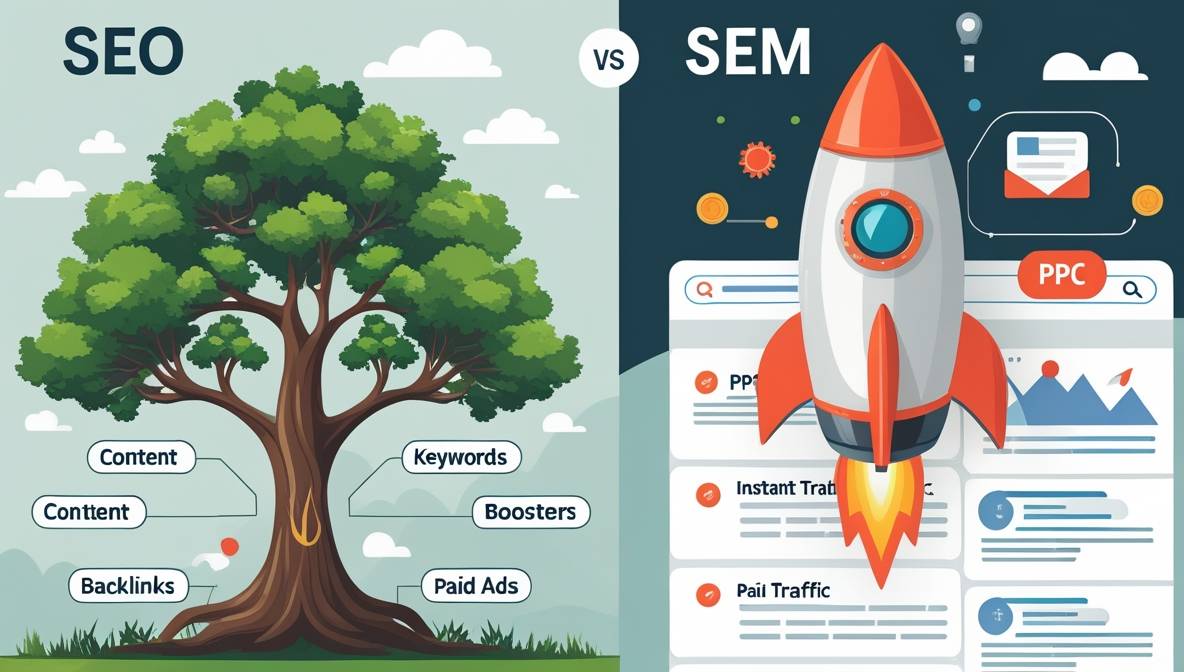Search Engine Optimization (SEO) and Search Engine Marketing (SEM) are foundational strategies in digital marketing, yet they serve distinct purposes. While SEO focuses on organic search rankings, SEM combines paid advertising with organic tactics to drive visibility. Understanding their differences and applications is critical for businesses aiming to maximize online reach.
Core Components of SEO and SEM
What is SEO?
Search Engine Optimization (SEO) enhances a website’s visibility in unpaid search results. It involves three pillars:
- On-Page SEO: Optimizing content, meta tags, and URLs. For instance, using tools like the Free Keyword Research Tool helps identify high-value terms.
- Off-Page SEO: Building authority through backlinks. Strategies like guest posting align with link-building best practices.
- Technical SEO: Improving site speed, mobile-friendliness, and crawlability. Tools such as the Website Speed Test Analyzer can pinpoint performance issues.
SEO’s long-term benefits include sustained organic traffic and enhanced credibility. For example, a local bakery using local SEO tactics can dominate “near me” searches.
What is SEM?
Search Engine Marketing (SEM) includes paid strategies like Pay-Per-Click (PPC) ads. Key elements include:
- Keyword Bidding: Competing for ad placements via platforms like Google Ads.
- Ad Copy Optimization: Crafting compelling messages to boost click-through rates.
- Landing Page Design: Ensuring pages align with ad promises, as outlined in on-page SEO guidelines.
SEM delivers immediate visibility, ideal for product launches or competitive markets. A startup might use SEM to attract investors while building organic traction.
Key Differences Between SEO and SEM
| Factor | SEO | SEM |
|---|---|---|
| Cost | Long-term investment (time/resources) | Immediate budget allocation (PPC bids) |
| Timeline | Months to see results | Instant visibility |
| Traffic Type | Organic | Paid |
| Sustainability | High (enduring rankings) | Low (stops when budget ends) |
For example, an e-commerce site might combine SEO for evergreen content and SEM for holiday sales.
When to Prioritize SEO or SEM
Choose SEO If:
- Your budget is limited, but timelines are flexible.
- Building brand authority is a priority.
- Competing in a niche with lower keyword difficulty.
Choose SEM If:
- Rapid results are critical (e.g., event promotions).
- Operating in a highly competitive industry.
- Testing new markets or products.
Businesses often blend both strategies. A tech company might use SEM to promote a new app while optimizing its blog for SEO.
Integrating SEO and SEM for Synergy
- Data Sharing: Use SEM keyword data to refine SEO strategies. High-performing PPC terms can inform organic content.
- Unified Messaging: Align ad copy with landing page content, ensuring consistency. Tools like the Article Rewriter can help adapt messaging across platforms.
- Budget Efficiency: Allocate resources based on campaign goals. For example, use SEM during peak seasons and SEO for evergreen growth.
Common Misconceptions Debunked
- “SEO Is Free”: While organic traffic isn’t paid, SEO requires investments in tools, content, and expertise.
- “SEM Is Only for Big Brands”: Small businesses can leverage localized PPC campaigns effectively.
- “SEO and SEM Are Rivals”: Combined, they offer short-term wins and long-term stability.
For deeper insights, explore SEO Best Practices for 2025.
External Resources for Further Learning
- Google’s Search Essentials: Understand algorithm updates here.
- Moz’s SEO Guide: A comprehensive resource on SEO basics here.
- Google Ads Help: Master PPC tactics here.
By strategically deploying SEO and SEM, businesses can achieve balanced digital growth. For actionable tools, explore RankWithSEOTools.

